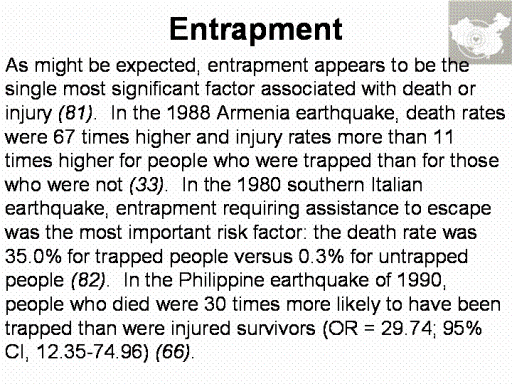| front |1 |2 |3 |4 |5 |6 |7 |8 |9 |10 |11 |12 |13 |14 |15 |16 |17 |18 |19 |20 |21 |22 |23 |24 |25 |26 |27 |28 |29 |30 |31 |32 |33 |34 |35 |36 |37 |38 |39 |40 |41 |42 |43 |44 |45 |review |
 |
Occupant's Location Within
a Building
In several past earthquakes
in the United States and in other countries, the location of people
at
the
time of the earthquake's impact has been shown to be an important
determinant of morbidity. For
example, the morbidity and mortality rate was significantly greater
for people who were indoors than for those who were outdoors when
earthquake shaking began (33,65,76,83).
Furthermore, occupants of
upper floors of multistory buildings have been observed to fare less
well
than ground-floor occupants.
For example, in Armenia, there was a significant "dose-response"
increase in risk for injury associated with the building floor
people were on at the moment of the earthquake.
People on the second to the fourth floor at the time of the
earthquake were 3.84 times more likely to be injured than those on
the first floor, and those on the fifth floor and higher were 11.20
times more likely to be injured (65).
Four out of five deaths in
the Loma Prieta earthquake occurred in motor vehicles on public
roadways (14). As in
nonearthquake situations, where motor vehicles account for more than
half of unintentional injury deaths (84), occupants of motor
vehicles appear to have a special risk of fatal injury in an
earthquake. As mentioned
above, in the Loma Prieta earthquake, a single circumstance, the
collapse of the Cypress Viaduct of Interstate 880 in Oakland,
accounted for 40 of 62 total earthquake-related deaths.
|